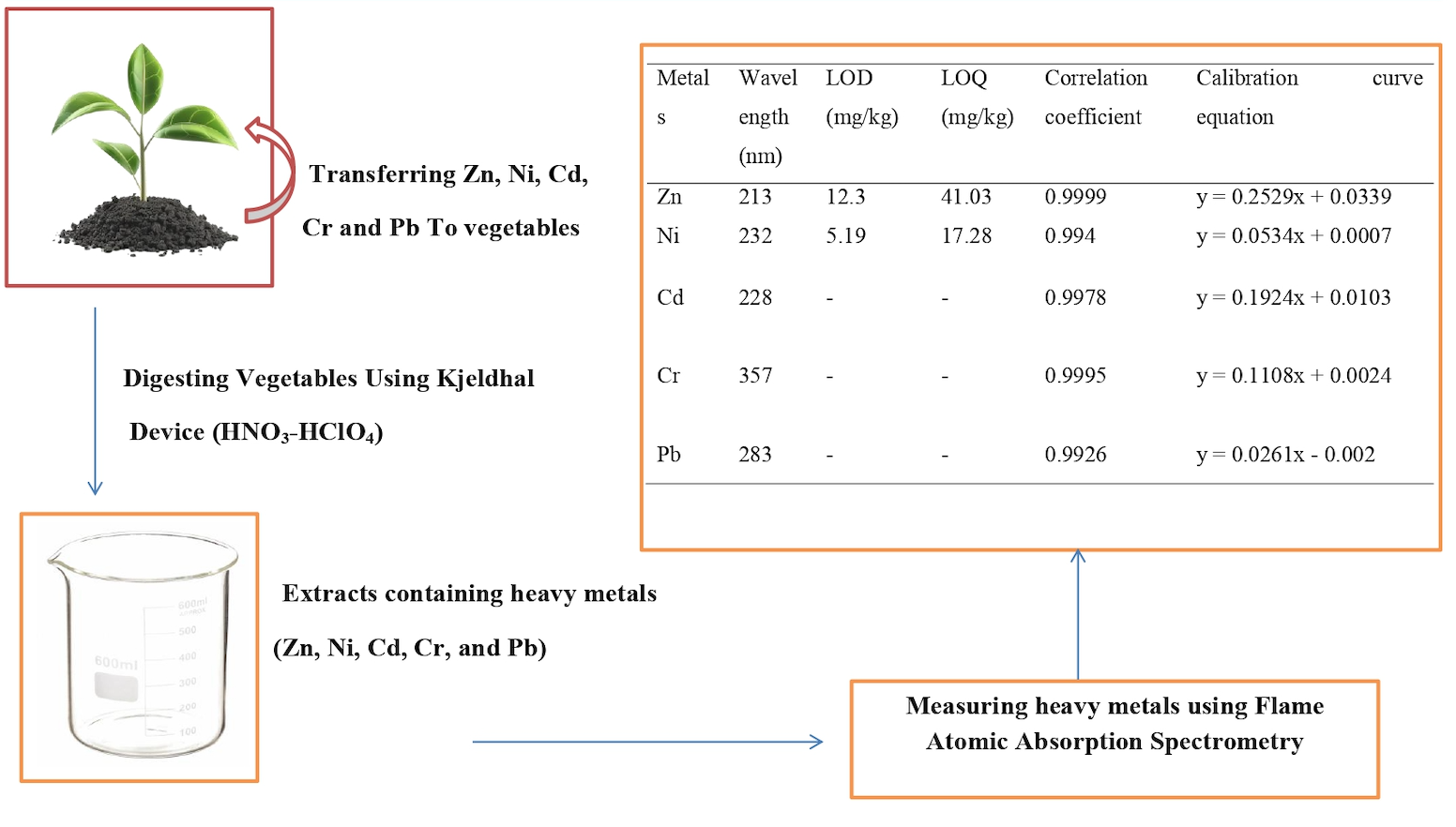Determination of selected heavy metals (Zn, Ni, Cd, Cr, and Pb) in Leafy Vegetables (Ethiopian Cabbage) cultivated around Dilla Town

Published 2025-05-09
Keywords
- Brassica family,
- Bioaccumulation,
- Cabbage,
- Wet Digestion,
- Heavy Metals
How to Cite
Copyright (c) 2025 Ayalew Mekuria, Samuel Gemeda, Elias Ture, Bilise Getachew

This work is licensed under a Creative Commons Attribution 4.0 International License.
Abstract
In the Dilla area, vegetables like cabbage can be grown in a variety of methods and are eaten in large quantities. In recent years, it has become more and more popular for people to eat more green leafy vegetables (GLV). Of the several GLVs that are acceptable for eating by humans, some are only found in a certain area, while others are found all over the world. The latter category, which includes the Brassica family, includes cabbage. The aim of this study was to use the technique known as flame atomic absorption spectrometry to investigate the levels of specific harmful heavy metals (Cr, Zn, Ni, Cd, and Pb) that are detected in the vegetables. To extract the metals from the samples, the most effective wet digestion technique was used. Heavy metal buildup in the body can result in a number of health risks. Therefore, accurate identification of these pollutants is necessary to ensure safety. Zn and Ni were discovered for the kinds of Kale examined, according to the analytical results from this study. Zn (47 to 114 mg/kg), Ni (28.6 to 39.7 mg/kg), Cr, Pb, and Cd are below detection limit, and other metal concentrations (mg/kg) were discovered in the edible sections of cabbage. However, the highest concentration of heavy metals was found in vegetables grown in Andida. From the study human nutrition in the subject area is the foods that are analyzed for metal content. Accordingly, both low-risk (adults and adolescents) and high-risk (children and pregnant women) must reduce their cabbage intake in light of the findings. The metals may bio accumulate with repeated ingestion, raising the danger to human health.
References
- Ahmet Balkaya & RuhsarYanmaz, “Promising kale (Brassica oleracea var. acephala) populations from Black Sea region, Turkey,” New Zeal. J. Crop Hortic. Sci. ISSN, vol. 0671, 2010, doi: 10.1080/01140671.2005.9514324.
- A. Lord and P. et. al. Thu Huong, “Chemical composition of kale as influenced by dry vermicast, potassium humate and volcanic minerals,” Food Res. Int., vol. 107, pp. 726–737, 2018, doi: 10.1016/j.foodres.2018.03.010.
- S Sarkiyayi and F M Samaila, “Determination of heavy metals in some selected vegetables cultivated in Sabon Tasha Yola , Adamawa State,” Direct Res. J. Agric. Food Sci., vol. 5, no. 12, pp. 427–432, 2017, doi: https://doi.org/10.26765/DRJAFS.2017.2079.
- Girmaye Benti, “Assessment of heavy metals in vegetables irrigated with Awash River in selected farms around Adama town,Ethiopia,” African J. Enviromental Sci. Technol., vol. 8, no. 7, pp. 428–434, 2014, doi: 10.5897/AJEST2014.1732.
- Surukite O. Oluwole et.al., “Determination of Heavy Metal Contaminants in Leafy Vegetables Cultivated By the Road Side,” Int. J. Eng. Res. Dev., vol. 7, no. 3, pp. 1–5, 2013.
- Getachew Alamnie et.al., “Heavy Metal Contamination in Green Leafy Vegetables Irrigated with Wastewater Collected from Harar Town Vegetable Farm ,Ethiopia,” Food Sci. Qual. Manag., vol. 94, pp. 24–28, 2020, doi: 10.7176/FSQM/94-03.
- Hamid Shirkhanloo et.al., “The evaluation and determination of heavy metals pollution in edible vegetables , water and soil in the south of Tehran province by GIS,” Arch. Environ. Prot., vol. 41, no. 2, pp. 64–74, 2015, doi: 10.1515/aep-2015-0020.
- Rahman M Azizur et.al., “Ecotoxicology and Environmental Safety Heavy metals in Australian grown and imported rice and vegetables on sale in Australia : Health hazard,” Ecotoxicol. Environ. Saf., vol. 100, pp. 53–60, 2014, doi: 10.1016/j.ecoenv.2013.11.024.
- H. Liu, S. Chen, C. Li, T. Li, Y. Wu, and Y. Liu, “Sequence Determination of Cd and Pb in Honey by Incomplete Digestion-High Resolution Continuum Source Graphite Furnace Atomic Absorption Spectrometry,” vol. 512, pp. 22–27, 2014, doi: 10.4028/www.scientific.net/AMM.511-512.22.
- W. Wubishet Gezahegn et.al., “Study of Heavy Metals Accumulation in Leafy Vegetables of Ethiopia,” IOSR J. Environ. Sci. Toxicol. Food Technol., vol. 11, no. 05, pp. 57–68, 2017, doi: 10.9790/2402-1105015768.
- Seyed Vali Hosseini et.al., “Determination of toxic ( Pb , Cd ) and essential ( Zn , Mn ) metals in canned tuna fish produced in Iran,” J. Environ. Heal. Sci. Eng., pp. 15–20, 2015, doi: 10.1186/s40201-015-0215-x.
- FAO/WHO, “Evaluation of certain food additives,” FAO/WHO, Geneva, Switzerland, 2012.
- Amare Hailu, “Metal Concentration in Vegetables Grown in Northern Addis Ababa and Part of Rift Valley ( Ziway ), Ethiopia,” 2007.
- MELAKU GIZAW, “Bioaccumulation and Toxicological Implication of Heavy Metals in Fish , and Vegetables Irrigated With Akaki River , Addis Ababa , Ethiopia,” 2018.
- Banchamlak Tegegne et.al., “Determination of the Level of Metallic Contamination in Irrigation Vegetables, the Soil, and the Water in Gondar City, Ethiopia,” Nutr. Diet. Suppl., vol. Volume 13, pp. 1–7, 2021, doi: 10.2147/nds.s283451.




